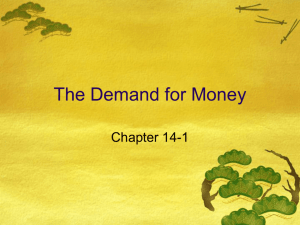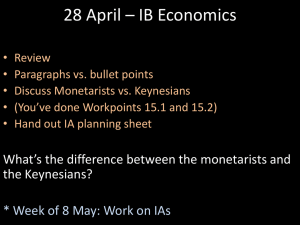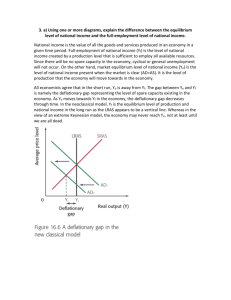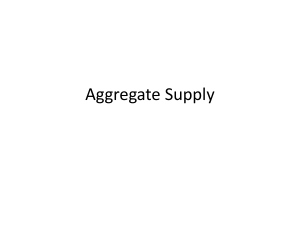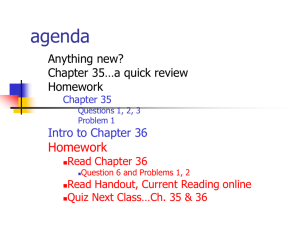Keynesian and Neoclassical Economics
advertisement
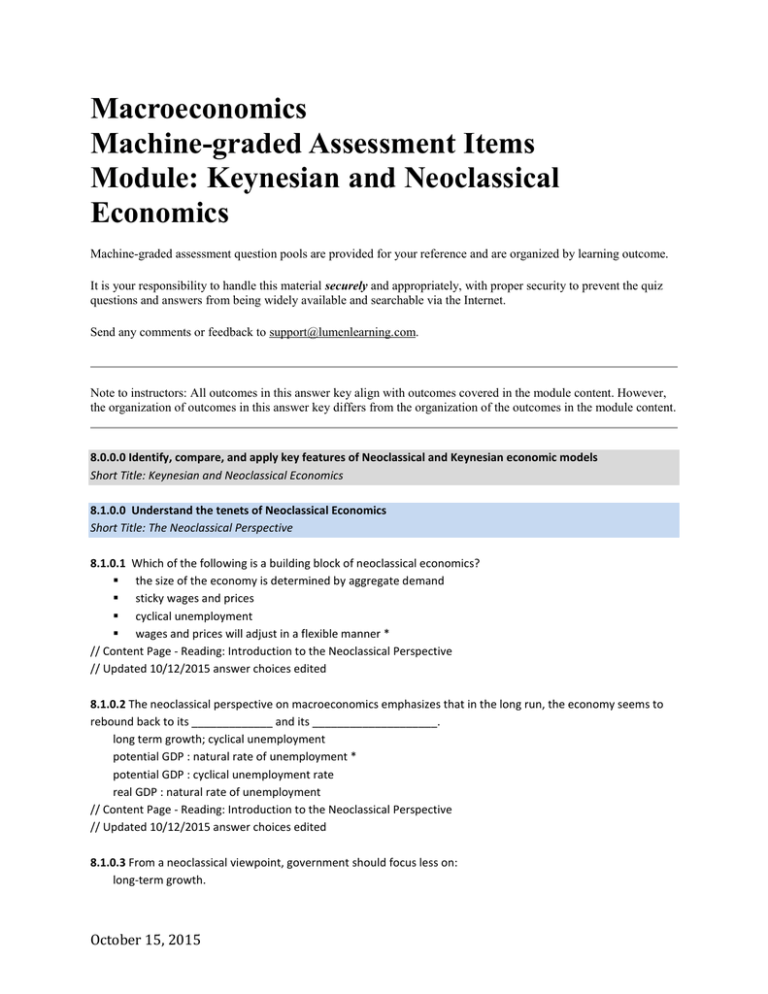
Macroeconomics Machine-graded Assessment Items Module: Keynesian and Neoclassical Economics Machine-graded assessment question pools are provided for your reference and are organized by learning outcome. It is your responsibility to handle this material securely and appropriately, with proper security to prevent the quiz questions and answers from being widely available and searchable via the Internet. Send any comments or feedback to support@lumenlearning.com. Note to instructors: All outcomes in this answer key align with outcomes covered in the module content. However, the organization of outcomes in this answer key differs from the organization of the outcomes in the module content. 8.0.0.0 Identify, compare, and apply key features of Neoclassical and Keynesian economic models Short Title: Keynesian and Neoclassical Economics 8.1.0.0 Understand the tenets of Neoclassical Economics Short Title: The Neoclassical Perspective 8.1.0.1 Which of the following is a building block of neoclassical economics? the size of the economy is determined by aggregate demand sticky wages and prices cyclical unemployment wages and prices will adjust in a flexible manner * // Content Page - Reading: Introduction to the Neoclassical Perspective // Updated 10/12/2015 answer choices edited 8.1.0.2 The neoclassical perspective on macroeconomics emphasizes that in the long run, the economy seems to rebound back to its _____________ and its ____________________. long term growth; cyclical unemployment potential GDP : natural rate of unemployment * potential GDP : cyclical unemployment rate real GDP : natural rate of unemployment // Content Page - Reading: Introduction to the Neoclassical Perspective // Updated 10/12/2015 answer choices edited 8.1.0.3 From a neoclassical viewpoint, government should focus less on: long-term growth. October 15, 2015 flexible prices. government stimulus spending.* cyclical unemployment. * // Content Page - Reading: The Neoclassical Perspective and Aggregate Demand and Supply // Updated 10/12/2015 answer choices edited 8.1.0.4 If a neoclassical model shows increasing wages in the economy in the short run, what else will likely occur? Change in government policy to decrease in aggregate demand. Leftward shift of the short-run aggregate supply curve.* Inflationary increase in price level.* Rightward shift of the short-run aggregate supply curve. // Content Page - Reading: Aggregate Demand and Supply Curves // Updated 10/12/2015 question and answer choices edited 8.1.0.5 In the neoclassical view, the economy has a ________________ to move back to potential GDP. rational tendency tendency to be unable self-correcting tendency* // Content Page - Reading: Introduction to the Neoclassical Perspective 8.1.0.6 ________________ economists place an emphasis on __________ run economic performance. Phillips : short Keynesian : long Neoclassical : long* Says : short // Content Page - Reading: Introduction to the Neoclassical Perspective 8.1.0.7 From a neoclassical view, which of the following is least important? fighting unemployment * encouraging long-term growth flexible prices level of potential GDP // Content Page - Reading: The Neoclassical Perspective and Aggregate Demand and Supply // Updated 10/12/2015 answer choices edited 8.1.0.8 From a neoclassical perspective, which of the following would most likely be viewed as an element that underpins long-run productivity growth in the economy? flexible price levels* government stimulus spending investments in human capital * cyclical unemployment // Content Page - Reading: The Neoclassical Perspective and Aggregate Demand and Supply // Updated 10/12/2015 answer choices edited 8.1.0.9 Which of the following schools of thought believe that the economy is self-regulating and always at full employment? October 15, 2015 Keynesian Supply-side Neo-classical* // Content Page - Reading: The Neoclassical Perspective and Aggregate Demand and Supply // Updated 10/12/2015 answer choices edited 8.1.0.10 The ___________________ perspective tends to view inflation as a cost that offers no offsetting gains in terms of lower unemployment. market forces Keynesian neoclassical* flexible wage and price // Content Page - Reading: Aggregate Demand and Supply Curves // Updated 10/12/2015 question edited 8.2.0.0 Understand the tenets of Keynesian Economics Short Title: The Keynesian Perspective 8.2.0.1 Keynes believed that the government should________ to get the economy out of recession decrease taxes and/or increase government spending.* increase taxes and reduce government spending. increase taxes and/or increase spending. // Content Page - Reading: The Building Blocks of Keynesian Analysis 8.2.0.2 Which of the following statements represents a Keynesian point of view of macroeconomics? Focus on long-term growth in the economy. Aggregate supply is the primary determinate of economic output. Creating increases in aggregate demand to reduce unemployment. * // Content Page - Reading: The Building Blocks of Keynesian Analysis // Updated 10/14/2015 answer choices edited 8.2.0.3 Which one of the following statements is akin to the Keynesian Perspective? Build it and they will come. We should build things. People’s demand determines what is built.* // Content Page - Reading: Keynes Law and Demand // Updated 10/14/2015 answer choices edited 8.2.0.4 According to the Huffington Post in February 2015, Canada ranked second to Greece in the amount of debt households had. How might this news affect consumption in Canada if one were to use the Keynesian perspective? Canadian consumption would not be affected Canadian households would consume more* Canadian household would consume less // Removed 10/14/2015 October 15, 2015 When the housing market crashed in 2007, Keynesian economists might have predicted a: decrease in consumption expenditure, as household wealth declined. * decrease in home purchases, as expected future incomes declined.* decrease in government spending to match declining tax revenues. // Content Page - Reading: Aggregate Demand in Keynesian Analysis // New 10/14/2015 8.2.0.5 What factors increase aggregate demand in the United States (AD shifts right)? U.S. households start to worry about the future and so start to consume less. U.S. firms decide to produce more in anticipation of the holiday season.* U.S. firms increase investment expenditure when forecasters predict a surge in U.S. consumer spending.* The United States puts an embargo on U.S. cars exported to Canada. // Content Page - Reading: Aggregate Demand in Keynesian Analysis // Updated 10/14/2015 answer choices edited 8.2.0.6 Consumption, investment, government spending, exports, and imports are: all complementary elements of a market economy. some of the opposing elements found in a market economy. all components of aggregate demand.* // Content Page - Reading: Aggregate Demand in Keynesian Analysis // Updated 10/14/2015 answer choices edited 8.2.0.7 Keynesian economics explains that recessions and depressions occur because: aggregate demand is not always automatically high enough to motivate firms to operate at full employment* the macroeconomy may adjust only slowly to shifts in aggregate demand because wages are sticky* there are long-term shifts in aggregate supply. // Content Page - Reading: The Building Blocks of Keynesian Analysis // Updated 10/14/2015 question and answer choices edited 8.2.0.8 The Keynesian view of economics assumes that: wages are sticky.* the economy must focus on long-term growth. economic output is primarily determined by aggregate supply. // Content Page - Reading: The Building Blocks of Keynesian Analysis // Updated 10/14/2015 answer choices edited 8.2.0.9 Which of the following is most strongly supported by the Keynesian perspective of macroeconomics? inflation might be necessary to achieve lower unemployment* inflation offers no offsetting gains in terms of higher unemployment there should be more emphasis on economic growth and how labor markets work // Removed 10/14/2015 According to the Keynesian theory of the expenditure multiplier, a change in autonomous expenditure will result in a(n): numerically larger change in GDP.* numerically smaller change in GDP. October 15, 2015 equivalent change in GDP. // Content Page - Reading: The Building Blocks of Keynesian Analysis, Reading: The Phillips Curve // New 10/14/2015 8.2.0.10 Referring to a Keynesian Phillips curve, a reduction in inflation is likely to cause: at least a slight increase in aggregate demand. at least a slight increase in unemployment.* at least a slight decrease in unemployment. // Content Page - Reading: The Phillips Curve // Updated 10/14/2015 answer choices edited 8.2.0.11 The Keynesian economic framework is based on an assumption that: an increase in government spending will cause the aggregate demand curve to shift to the left. prices and wages are sticky and do not adjust rapidly. * people can afford a high level of government services. // Content Page - Reading: The Building Blocks of Keynesian Analysis // Updated 10/14/2015 answer choices edited 8.2.0.12 Which of the following is consistent with Keynesian theory? A typical firm changes its prices frequently to adjust to changes in aggregate demand. A typical firm does not change its prices immediately when aggregate demand fluctuates.* The economy is always at full employment. // Content Page - Reading: The Building Blocks of Keynesian Analysis 8.2.0.13 Which of the following statement(s) about economic models is false? In the neoclassical model, the real wage adjusts to move the economy to full employment. In the Keynesian model, the real wage adjusts to move the economy to full employment.* In the Keynesian model, equilibrium is achieved by adjustments in aggregate demand, which equals aggregate income. In the Keynesian model, equilibrium may be achieved at less than full employment level. // Updated 10/14/2015 answer choices edited 8.2.0.14 Fill in the blanks. According to the Keynesian perspective, the government __________ a role in managing the macroeconomy ___________. has : especially when actions by consumers, firms, and trading partners are weak or fall short of expectations* does not have : anytime does not have : when there is unemployment and inflation has : especially in the long run // Content Page – Reading: Balancing Keynesian and Neoclassical Models 8.2.0.15 According to macroeconomic theory, evidence that high unemployment may be accompanied by low inflation, and low unemployment may be accompanied by high inflation is illustrated by the: neoclassical aggregate demand-aggregate supply model. Keynesian cross diagram. Keynesian Phillips curve tradeoff. * Keynesian aggregate demand-aggregate supply model. October 15, 2015 // Content Page – Reading: The Phillips Curve // Updated 10/14/2015 answer choices edited 8.2.0.16 The ________ suggests a negative relationship between inflation and unemployment. short run Phillips curve* aggregate demand curve long run Phillips curve // Content Page – Reading: The Phillips Curve 8.3.0.0 Apply the tenets through the aggregate supply and demand model Short Title: Applying the AS/AD Model 8.3.0.1 Moving along the aggregate demand curve, a decrease in real GDP is associated with which of the following? An increase in the price level* A decrease in the price level An increase in income An increase in wealth // Content Page – Reading: The Building Blocks of Keynesian Analysis // Updated 10/14/2015 answer choice edited 8.3.0.2 In the neoclassical version of the AD/AS model, which of the following should you use to represent the long run AS curve? The long run AS curve shifting right as productivity increases.* An upward sloping short-run AS curve with a horizontal top. A vertical line drawn at the level of potential GDP.* The long-run AS curve shifting right as potential GDP expands.* // Content Page – Reading: The Neoclassical Perspective: // Updated 10/14/2015 question and answer choices edited 8.3.0.3 In the Keynesian version of the AD/AS model, which of the following should you use to represent the AS curve? The AS curve shifting as productivity increases. An upward sloping curve with a vertical top. A horizontal line drawn at the existing aggregate price level. * The AS curve shifting as potential GDP expands. // Reading: Video: Macroeconomic Perspectives. 8.3.0.4 Aggregate demand is more likely than aggregate supply to _________________ in the short run. shift substantially * remain unchanged increase slightly // Content Page - Reading: Balancing Keynesian and Neoclassical Models // Updated 10/15/2015 distractor removed October 15, 2015 8.3.0.5 If aggregate supply is vertical, then which of the following statements must be true? Aggregate demand does not affect the quantity of output.* Aggregate demand does not cause inflationary changes in the price level. Inflation will accompany any rise in output. // Content Page - Reading: Keynes Law and Says Law In the Ad-AS Model // Updated 10/15/2015 distractor removed 8.3.0.6 In the neoclassical model, economic growth over time shifts potential GDP and the ______________ gradually to the right. vertical AS curve * vertical AD curve vertical Phillips curve // Content Page – Reading: Aggregate Demand and Supply Curves 8.3.0.7 In the neoclassical model, the AS curve shifts to the right over time as _______________________ and potential GDP expands. the macroeconomy adjusts back to real GDP productivity increases * the level of real output drops // Reading: The Neoclassical Perspective and Aggregate Demand and Supply // Updated 10/15/2015 distractor removed 8.3.0.8 Over the long run, a surge in aggregate demand from a neoclassical perspective will most likely result in: a rise in level of output an increase in the price level * downward pressure on the price level // Content Page - Reading: Neoclassical Perspective and Flexible Prices // Updated 10/15/2015 distractor removed 8.3.0.9 Suppose that a rise in business confidence has led to more investment in the economy and higher levels of output. In the short-run Keynesian analysis, the rise in aggregate demand will: lower unemployment* cause government to lower taxes cause exports to drop // Content Page - Reading: Aggregate Demand in Keynesian Analysis // Updated 10/15/2015 distractor removed 8.3.0.10 Which of the following factors would NOT lead to a shift in the aggregate demand curve? A cut in personal income tax rates High consumer confidence Increased defense spending An increase in the price level* // Content Page - Reading: Building a Model of Aggregate Demand and Supply // Updated 10/15/2015 question and answer choices edited 8.3.0.11 The slope of the ______________ shows a tradeoff between unemployment and inflation. aggregate demand curve October 15, 2015 aggregate supply curve Phillips curve* Keynesian demand curve // Content Page - Reading: The Phillips Curve // Updated 10/15/2015 question wording improved 8.3.a.0 Identify the Keynesian portion of the AS curve and explain the logic for it Short Title: The Keynesian Portion of the AS Curve 8.3.a.1 What is the best explanation for the slope of the Keynesian zone of the aggregate supply curve? an increase in aggregate demand when the economy is operating below potential output causes real output to grow, with little or no effect on the price level.* an increase in aggregate demand causes both real output and the price level to increase. an increase in aggregate demand when the economy is operating at potential output causes the price level to rise, with little or no effect on real output. // Content Page - Reading: The Phillips Curve // Updated 10/15/2015 question and answer choice wording improved 8.3.a.2 In the Keynesian version of the AD/AS model, which of the following should you use to represent the AS curve? the AS curve shifting as productivity increases an upward sloping curve with a vertical top a horizontal line drawn at the existing aggregate price level * the AS curve shifting as potential GDP expands // Removed 10/14/2015 During the 1970s and 1980s, the U.S. Phillips curve demonstrated: increases in both inflation and unemployment at the same time. * increase in inflation with decreases in unemployment. decreases in inflation with increases in unemployment. // Content Page - Reading: The Phillips Curve // New 10/14/2015 8.3.a.2 What is the best explanation for the slope of the Neoclassical zone of the aggregate supply curve? A small increase in aggregate demand when the economy is operating below its potential output will not have much effect on the price level. An increase in aggregate demand causes both real output and the price level to increase. A small an increase in aggregate demand when the economy is operating at potential output causes the price level to rise, with little or no effect on real output.* // Content Page - Reading: The Phillips Curve // New 10/14/2015 During the 1990s and early 2000s, the U.S. Phillips curve demonstrated: decreases in both inflation and unemployment at the same time. * increase in inflation with decreases in unemployment. October 15, 2015 decreases in inflation with increases in unemployment. // Content Page - Reading: The Phillips Curve // New 10/14/2015 8.3.a.3 A horizontal AS curve means that changes in GDP will be caused by: cyclical unemployment changes in potential output. changes in aggregate demand. * // Content Page – Reading: Aggregate Demand in Keynesian Analysis 8.3.a.4 A typical Keynesian Phillips curve _____________. slopes downward * is vertical slopes upward // Content Page - Reading: The Phillips Curve // Updated 10/14/2015 question and answer choices edited 8.3.b.0 Use the Income-Expenditure model to explain periods of recession and expansion Short Title: The Expenditure Output Model 8.3.b.1 In a Keynesian cross diagram, what name is given to the distance between an output level that is below potential GDP and the level of potential GDP? expenditure-output inflationary gap recessionary gap* // Content Page – Reading: Equilibrium and the Expenditure-Output Model // Updated 10/14/2015 distractor removed 8.3.b.2 Fill in the blanks. As disposable income increases, consumption expenditures ________ and autonomous consumption will _______. increase; remain the same* increase; increase decrease; remain the same decrease; increase // Removed 10/14/2015 Causes of a recessionary gap are a(n): decline in consumption.* decline in savings. fall in investment.* increase in government spending. // Content Page – Reading: Equilibrium and the Expenditure-Output Model // New 10/14/2015 If the economy is experiencing an inflation gap, the equilibrium level of GDP is: greater than potential GDP.* October 15, 2015 less than potential GDP. equal to potential GDP. // Content Page – Reading: Equilibrium and the Expenditure-Output Model // New 10/14/2015 8.3.b.3 When the economy is in a recession, the government will want to increase output. If the multiplier equals 2.5 and the government increases spending by 200, how much will output increase by? 300 500 * 900 // Content Page – Reading: The Multiplier Effect // Updated 10/14/2015 distractor removed 8.3.b.4 The economy is in a recession and the government wants to increase output. If the multiplier equals 3 and the government increases spending by 250, how much will output increase by? 50 100 200 750 * // Content Page – Reading: The Multiplier Effect 8.3.b.5 If John’s consumption expenditure increases from $2500 to $3500 when his disposable income increases from $4000 to $6000, then which of the following is true? John is dissaving. John’s consumption function has a slope of 0.2. John’s consumption function has a slope of 0.5.* John’s consumption function has shifted. // Removed 10/14/2015 // Content Page - Reading: Equilibrium and the Expenditure-Output Model The value of the multiplier will fall due to these leakages a(n): increase in the tax rate.* decrease in the propensity to import goods and services. increase in government spending. increase in the propensity to save.* // Content page – Reading: The Multiplier Effect // New 10/14/2015 8.3.b.6 If the slope of the Aggregate Expenditure curve is 0.4, what would the value of the multiplier be? 1.67* 0.4 0.6 2.5 // Removed 10/14/2015 8.3.b.6 Assume an economy has a multiplier of 5. If a government stimulus program spends $500 million, what will be the resulting change in real GDP? October 15, 2015 $500 million $2.5 billion* $100 million $5 billion // Content page – Reading: The Multiplier Effect // New 10/14/2015 8.3.b.7 Why does the multiplier effect exist? Because a change in expenditures leads to changes in income, which generates further spending* Because a change in expenditures induces households to save Because a change in expenditures induces the country to export Because a change in expenditures is part of the government’s stabilization policy // Content Page - Reading: The Multiplier Effect // Updated 10/14/2015 answer choices edited 8.3.c.0 Find the GDP Gap (negative or positive) Short Title: The GDP Gap 8.3.c.1 When real GDP is less than potential real GDP, the economy is experiencing a GDP gap * inflation unemployment * // Content Page – Reading: The GDP Gap 8.3.c.2 The GDP gap shrinks as the economy recovers from recession. * as the Fed contracts the economy. as the government uses discretionary fiscal policy to reduce the budget deficit. // Content Page – Reading: The GDP Gap 8.3.c.3 Over the long run, the GDP gap tends to be zero. * tends to be positive. tends to be negative. // Content Page - Reading: The GDP Gap 8.3.c.4 When the economy experiences an inflationary boom, the GDP gap is: positive. negative.* zero. // Content Page – Reading: The GDP Gap // New 10/14/2015 8.3.d.0 Identify the Neoclassical portion of the AS curve and explain the logic for it Short Title: The Neoclassical Portion of the AS Curve October 15, 2015 8.3.d.1 A vertical AS curve means that the level of aggregate supply (or potential GDP) will determine the real GDP of the economy, regardless of the level of: cyclical unemployment. real unemployment. aggregate demand.* // Content Page – Reading: The Neoclassical Perspective and Aggregate Demand and Supply 8.3.d.2 Neoclassical economists argue that: the long run aggregate supply curve is vertical* the long run aggregate supply curve is at the level of potential GDP* the long run aggregate supply curve moves gradually to the left as potential GDP grows // Content Page – Reading: The Neoclassical Perspective // Updated 10/14/2015 answer choice wording improved 8.3.d.3 What is the best explanation for the slope in the Neoclassical portion of the aggregate supply curve? an increase in aggregate demand when the economy is operating below potential output causes real output to grow, with no effect on the price level. an increase in aggregate demand causes real output to grow and the price level to increase. an increase in aggregate demand when the economy is operating at potential output causes the price level to rise, with no effect on real output.* // Removed 10/14/2015 (duplicate question) // Content Page - Reading: Aggregate Demand and Supply Curves 8.3.d.3 An increase in AD curve along the Neoclassical portion of the aggregate supply curve will result in: no effect on the price level. an increase in the price level.* a decrease in the price level. // New 10/14/2015 8.3.e.0 Differentiate between the long run and short run aggregate supply curves Short Title: Long Run and Short Run AS Curves 8.3.e.1 Why do neoclassical economists tend to put relatively more emphasis on long-term growth than on fighting recession? Price and wage stickiness is reasonable in the short run. Government focuses more on recession and cyclical unemployment. In the long run, the size of the economy is determined by potential GDP.* The upward trend of potential GDP determines the rate of inflation. // Reading: The Neoclassical Perspective in AD/AS // Updated 10/14/2015 answer choices edited 8.3.e.2 An accurate interpretation of the long-run aggregate supply curve acknowledges both that real GDP does not vary with the price level and: cyclical unemployment is zero* October 15, 2015 structural unemployment is zero frictional unemployment is zero total unemployment is zero // Reading: The Neoclassical Perspective in AD/AS // Updated 10/14/2015 answer choices wording improved 8.3.e.3 Which of the following accurately contrasts short-run and long-run equilibrium? In short-run equilibrium, the aggregate demand curve intersects the short-run aggregate supply curve; in the long-run equilibrium, the aggregate demand curve intersects the long-run aggregate supply curve. * In short-run equilibrium, the aggregate demand curve intersects the short-run aggregate supply curve; in the long-run equilibrium, the aggregate demand curve intersects the long-run aggregate expenditures curve. In short-run equilibrium, the aggregate demand curve intersects the long-run aggregate supply curve; in longrun equilibrium, the aggregate demand curve intersects the short-run aggregate supply curve. // Reading: The Neoclassical Perspective in AD/AS 8.4.0.0 Compare and contrast the circumstances under which it makes sense to apply the Keynesian and Neoclassical perspectives Short Title: Apply the Keynesian and Neoclassical Perspectives 8.4.0.1 If markets throughout the global economy all have flexible and continually adjusting prices, then: all market-oriented economies should implement coordinated wage reductions. each economy will head more quickly toward its natural rate of unemployment. * each economy must increase its aggregate demand and create additional employment. all changes in prices and wages will create additional employment. // Reading: The Neoclassical Perspective in AD/AS // Updated 10/14/2015 answer choices edited 8.4.0.2 If an economy experiences a decrease in aggregate demand due to a decline in consumer confidence and output falls below potential GDP, which of the following is likely to occur in the short run? Less consumption and more saving.* Adjustment back to potential GDP. Increase in price inflation. A rise in unemployment.* // Content Page – Reading: Aggregate Demand and Supply Curves // Updated 10/14/2015 question edited 8.4.0.3 The Keynesian model focuses more on ______ and the neo-classical model focuses more on _____. Short term fluctuations caused by business cycles : long-run determinants of output and employment.* Long-run determinants of output and employment : short term fluctuations caused by business cycles. Short term fluctuations caused by technological change and labor force growth : long-run determinants of output and employment. // Content Page – Reading: Speed of Macroeconomic Adjustment // Updated 10/14/2015 answer choices formatting improved October 15, 2015
